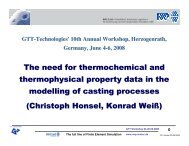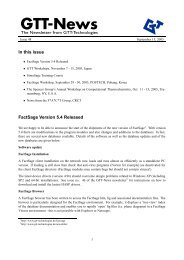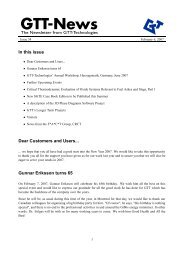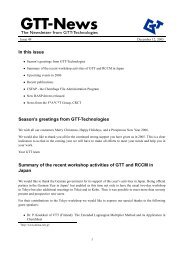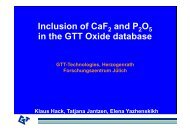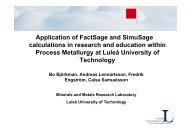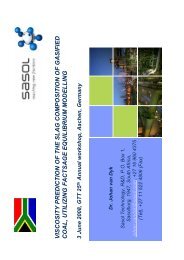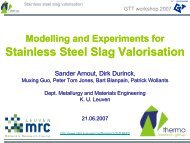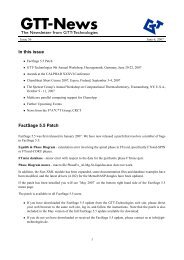full presentation - RWTH Aachen University
full presentation - RWTH Aachen University
full presentation - RWTH Aachen University
You also want an ePaper? Increase the reach of your titles
YUMPU automatically turns print PDFs into web optimized ePapers that Google loves.
Current ChemApp<br />
Developments and Projects<br />
Stephan Petersen, GTT-Technologies<br />
GTT-Technologies’ 10th Annual Workshop, June 4 - 6, 2008
GTT-Technologies<br />
GTT Workshop 2008<br />
0. Overview<br />
• Recent ChemApp developments<br />
• Parallelization of ChemApp with<br />
OpenMP<br />
• Current ChemApp projects
GTT Workshop 2008<br />
1. Recent ChemApp<br />
developments<br />
New subroutines to manipulate thermochemical data<br />
(read from a data-file in ASCII format):<br />
TQGDAT Get selected thermodynamic data of a phase<br />
constituent<br />
TQLPAR List all excess Gibbs energy or all excess magnetic<br />
interactions of a phase<br />
TQGPAR Get selected excess Gibbs energy or excess magnetic<br />
parameters of a phase<br />
TQCDAT Change selected data of a specified phase constituent<br />
or of a specified phase<br />
TQWASC Write a thermodynamic data-file in ASCII format
GTT Workshop 2008<br />
Code example - data manipulation<br />
C Retrieving and changing thermodynamic data<br />
PROGRAM CAF33<br />
IMPLICIT NONE<br />
INTEGER NOERR, INDEXP, NVALV, I, J, NOPAR, NOEXPR, NVALA<br />
INTEGER LGTPAR(1999)<br />
DOUBLE PRECISION VALV(25),VALA(20,18)<br />
CHARACTER*156 CHRPAR(1999)<br />
C Initialise ChemApp<br />
CALL TQINI(NOERR)<br />
C Open the thermochemical data-file fec.dat (system Fe-C)<br />
C for reading<br />
CALL TQOPNA('fec.dat', 10, NOERR)<br />
C Read data-file<br />
CALL TQRFIL(NOERR)<br />
C NOTE: Do not yet close the data-file, otherwise tqwasc (see below)<br />
C won't be able to access the commentary block in fec.dat in order<br />
C to attach it to the new file.
GTT Workshop 2008<br />
Code example - data manipulation<br />
C Get the index number of phase 'C_GRAPHITE'<br />
CALL TQINP('C_GRAPHITE ', INDEXP, NOERR)<br />
C Retrieve Cp coefficients for the first Cp-range of C_GRAPHITE<br />
CALL TQGDAT(INDEXP, 1, 'Cp ', 1, NVALV, VALV, NOERR)<br />
C Print coefficients<br />
DO I=1, NVALV<br />
WRITE(UNIT=*,FMT=*) 'VALV(',I,') is ', VALV(I)<br />
ENDDO<br />
Output:<br />
VALV( 1) is 24.3<br />
VALV( 2) is 0.0009446<br />
VALV( 3) is 0.<br />
VALV( 4) is -5125200.<br />
VALV( 5) is 1.5858E+09<br />
VALV( 6) is -3.<br />
VALV( 7) is -1.44E+11<br />
VALV( 8) is -4.
GTT Workshop 2008<br />
Code example - data manipulation<br />
Options for use with TQGDAT<br />
H Enthalpy/J at 298.15 K<br />
S Entropy/J.K-1 at 298.15 K<br />
Cp Heat capacity expression/J.K-1 or Helgeson terms for the<br />
models PIHZ, HELZ, HTSZ, HTWZ or HTDZ<br />
Tt Upper temperature limit/K for a Cp range<br />
Ht Transformation enthalpy/J at the upper temperature limit for a<br />
Cp range<br />
V Molar volume data in input order of a condensed phase<br />
constituent<br />
Gc Critical properties in input order of a gas phase constituent<br />
M Curie/Neel temperature and average magnetic moment per atom<br />
for a magnetic phase constituent<br />
Ch Charge of an aqueous phase constituent
GTT Workshop 2008<br />
Code example - data manipulation<br />
C Get the phase index number of phase 'Fe3C_CEMENTITE'<br />
CALL TQINP('Fe3C_CEMENTITE ', INDEXP, NOERR)<br />
C Retrieve Enthalpy/J at 298.15 K of Fe3C_CEMENTITE<br />
CALL TQGDAT(INDEXP, 1, 'H ', 1, NVALV, VALV, NOERR)<br />
WRITE(UNIT=*,FMT=*) 'Enthalpy/J at 298.15 K of Fe3C_CEMENTITE: ',<br />
* VALV(1)<br />
C Set the enthalpy/J at 298.15 K of Fe3C_CEMENTITE to a new value<br />
CALL TQCDAT(1, 0, 0, 1, INDEXP, 20000.D0, noerr)<br />
CALL TQGDAT(INDEXP, 1, 'H ', 1, NVALV, VALV, NOERR)<br />
WRITE(UNIT=*,FMT=*) 'New enthalpy/J at 298.15 K of ' //<br />
* 'Fe3C_CEMENTITE: ', VALV(1)<br />
C Write data to file<br />
WRITE(UNIT=*,FMT=*) 'Writing modified data-file to fec_mod.dat'<br />
CALL TQWASC('fec_mod.dat', noerr)<br />
WRITE(UNIT=*,FMT=*) 'Done'<br />
Output:<br />
Enthalpy/J at 298.15 K of Fe3C_CEMENTITE: 25211.89<br />
New enthalpy/J at 298.15 K of Fe3C_CEMENTITE: 20000.<br />
Writing modified data-file to fec_mod.dat<br />
Done
GTT Workshop 2008<br />
Code example - data manipulation<br />
C NOW close the data-file fec.dat, AFTER tqwasc has been called<br />
CALL TQCLOS(10, NOERR)<br />
C Get index number of phase FCC_A1<br />
CALL TQINP('FCC_A1 ', INDEXP, NOERR)<br />
C Retrieve all excess Gibbs energy interactions in phase FCC_A1<br />
CALL TQLPAR(INDEXP, 'G ',NOPAR, CHRPAR, LGTPAR, NOERR)<br />
WRITE(UNIT=*,FMT=*) 'Excess Gibbs energy interactions ' //<br />
* 'in phase FCC_A1:'<br />
C Print them<br />
DO I=1, NOPAR<br />
WRITE(UNIT=*,FMT=*) 'CHRPAR(',I,') is ',<br />
* CHRPAR(I)(1:LGTPAR(I))<br />
ENDDO<br />
Output:<br />
Excess Gibbs energy interactions in phase FCC_A1:<br />
CHRPAR( 1) is 1: *2 ( 1)-( 2)
GTT Workshop 2008<br />
Code example - data manipulation<br />
C Retrieve the Gibbs energy parameters for the first (and only) interaction<br />
C in phase FCC_A1<br />
CALL TQGPAR(INDEXP, 'G ', 1, noexpr, nvala, vala, noerr)<br />
Output:<br />
WRITE(UNIT=*,FMT=*) 'Printing Gibbs energy parameters for ' //<br />
* 'this interaction:'<br />
WRITE(UNIT=*,FMT=*) 'noexpr is ', noexpr<br />
WRITE(UNIT=*,FMT=*) 'nvala is ', nvala<br />
do i=1, noexpr<br />
do j=1, nvala<br />
WRITE(UNIT=*,FMT=*) 'noexpr = ',i,', nvala = ',j, ': ',<br />
* vala(i,j)<br />
enddo<br />
enddo<br />
Printing Gibbs energy parameters for this interaction:<br />
noexpr is 1<br />
nvala is 4<br />
noexpr = 1, nvala = 1: -34671.<br />
noexpr = 1, nvala = 2: 0.<br />
noexpr = 1, nvala = 3: 0.<br />
noexpr = 1, nvala = 4: 0.<br />
END
GTT-Technologies<br />
GTT Workshop 2008<br />
2. Parallelization of ChemApp<br />
with OpenMP<br />
• ChemApp is being adapted to the current generation<br />
of multi-core processors by parallelizing it.<br />
• Parallelization is an optimization technique to<br />
distribute work load efficiently on a multiple<br />
processor machine via multiple threads.<br />
• Parallelization can reduce computation time<br />
significantly on a multi-core processor.<br />
• OpenMP is used to efficiently parallelize<br />
ChemApp for multi-core processors.
GTT Workshop 2008<br />
Parallelization of ChemApp<br />
ChemApp<br />
Single<br />
Core<br />
CPU<br />
Results<br />
Computational Time<br />
ChemApp<br />
Core 1 Core 2<br />
Results<br />
Serial Execution Parallel Execution (shared memory)<br />
Schematic re<strong>presentation</strong> of Serial Execution vs. Parallel Execution of<br />
ChemApp on a shared memory architecture with significantly reduced<br />
computation time.<br />
Computational Time
GTT-Technologies<br />
GTT Workshop 2008<br />
Parallelization of ChemApp<br />
• Parallelized version of ChemApp can run<br />
multiple threads depending upon the processor<br />
cores.<br />
– The number of threads are dynamically allotted but<br />
can be manually set via the environment variables.<br />
• The parallelized version of ChemApp is designed<br />
with emphasis on faster calculation of<br />
thermochemical equilibria (subroutine TQCE).<br />
– Calculation of thermochemical equilibrium is<br />
typically the most computational intensive part of<br />
ChemApp code.
GTT-Technologies<br />
GTT Workshop 2008<br />
Parallelization of ChemApp<br />
• This initial parallelized version of ChemApp<br />
will be available only for shared memory<br />
architectures (multi-core CPUs + OpenMP)<br />
and not distributed memory architectures<br />
(Grids and Clusters + MPI/PVM).<br />
• The current OpenMP parallelized version of<br />
ChemApp can still run on a cluster but needs<br />
additional MPI language bindings in the main<br />
program which calls ChemApp for maximum<br />
cluster performance.
GTT-Technologies<br />
GTT Workshop 2008<br />
Performance Overview<br />
Parallel performance is largely dependent on:<br />
– Parallel Computing Infrastructure<br />
• Number of cores in a processor<br />
• Speed of the individual cores<br />
• Memory capacity and latency<br />
– Programming Style and Algorithm<br />
• Efficient memory handling and allocation<br />
• Performing more thermochemical equilibrium calculations can<br />
extract more parallel performance from ChemApp<br />
– Amdahl’s Law<br />
• Performance starts to degrade after a point<br />
• A program might run faster on a quad core or 8 core CPU than<br />
on a 16 core CPU (not necessarily always and depends on a<br />
number of factors)
GTT-Technologies<br />
GTT Workshop 2008<br />
Parallel Performance
GTT-Technologies<br />
GTT Workshop 2008<br />
Anticipated Parallel Performance<br />
• On a typical dual-core processor,<br />
performance might scale between a factor of<br />
1.2x and 1.75x of serial execution.<br />
• On a higher number of processing cores and<br />
with a suitable parallelizable problem,<br />
performance can scale up to a generic factor<br />
of 0.75 x number of cores but is inhibited by<br />
Amdahl‘s law.
GTT-Technologies<br />
GTT Workshop 2008<br />
3. Current ChemApp projects<br />
For examples of ChemApp applications, see Stephan<br />
Petersen and Klaus Hack: “The thermochemistry library<br />
ChemApp and its applications”, Int. J. Mat. Res., vol<br />
98(10), 2007, p. 935<br />
Development of a new<br />
Nuclear Fuel Rod Model<br />
Srdjan Simunovic, Larry J. Ott, Phani K. Nukala,<br />
Kevin T. Clarno, B. Radhakrishnan, Ted Besmann and<br />
Gorti Sarma, ORNL
DEVELOPMENT OF A NEW NUCLEAR<br />
FUEL ROD MODEL<br />
Managed by UT-Battelle<br />
for the Department of Energy<br />
Srdjan Simunovic 1 , Larry J. Ott 2 ,<br />
Phani K. Nukala 1 , Kevin T. Clarno 2 ,<br />
B. Radhakrishnan 1 , Ted Besmann 3<br />
and Gorti Sarma 1<br />
1 Computer Science and Mathematics Division<br />
2 Nuclear Science & Technology Division<br />
3 Materials Science & Technology Division
Fuels Fuels Modeling Modeling is is is Inherently Inherently Multiscale<br />
Multiscale<br />
ps-ns ns-µµs µs-s s-year decades<br />
T<br />
Point defect<br />
properties<br />
E f , E m ,…<br />
(ab initio)<br />
MD simulation of He<br />
mobility in UO 2 gb<br />
g.b.<br />
Defect & fission<br />
product<br />
production<br />
(molecular<br />
dynamics, fission<br />
track, thermal<br />
spike)<br />
-900<br />
500 1000 1500 2000 2500 3000<br />
Defect & fission<br />
product<br />
migration, bubble<br />
nucleation<br />
(kinetic Monte Carlo,<br />
rate theory)<br />
T Irradiated fuel<br />
chemistry & phase<br />
stability<br />
(thermodynamics,<br />
chemistry, reaction<br />
rate theory)<br />
2 Managed by UT-Battelle<br />
for the Department of Energy Presentation_name<br />
FUNCTION MUO2<br />
0<br />
-100<br />
-200<br />
-300<br />
-400<br />
-500<br />
-600<br />
-700<br />
-800<br />
UO 2+x<br />
Fuel<br />
performance<br />
(k, FP, micro)<br />
0<br />
0.0001 0<br />
0.001 0.01 0.1<br />
Damage Level (dpa)<br />
Fuel-cladding<br />
interactions<br />
(fuel swelling,<br />
chemistry,<br />
microstructure<br />
and deformation)<br />
Fuel element<br />
(neutronics, flow,<br />
thermal,<br />
mechanics)<br />
50 GWd/MT MOX<br />
Å-nm nm-µm<br />
µm-mm mm-m<br />
Thermal Conductivity (W/m-K)<br />
120<br />
100<br />
80<br />
60<br />
40<br />
20<br />
Aluminum Nitride<br />
Silicon Nitride<br />
60°C Irradiation<br />
300°C Irradiation<br />
ORNL is engaged in relevant<br />
research activities at each scale<br />
and has a strong track record of<br />
linking theory and experiments<br />
L
ORNL Model Development Strategy<br />
• Top-down approach<br />
• As modular as possible<br />
• Assume two categories of phenomena:<br />
– Nuclear power generation, material structural changes, fission<br />
products, chemistry - micro scale<br />
– Transport (power, species), mechanics - macro scale<br />
• Weak coupling between micro and macro phenomena<br />
– e.g. material structural changes are used as input data for thermomechanics<br />
loop<br />
• Utilize current fuel codes as much possible<br />
– e.g. for initiation of 3D states for detailed analysis<br />
• Combine elements of computer codes with proven parallel<br />
performance<br />
3 Managed by UT-Battelle<br />
for the Department of Energy Presentation_name
Why High Performance Computing?<br />
• Spatial resolution: Fundamental physics occurs at the<br />
grain size level (10-20 µm) in the fuel pellet<br />
• Multiple sub-models: Each with high resolution<br />
• Coupling: Increase in coupling increases problem size<br />
• Process time of interest: Minutes, Hours and Days<br />
• Simple example:<br />
– Mesh resolution (h) for crack modeling for CPI estimated from<br />
material toughness (energy dissipated for failure) and strength<br />
– Adding microstructure and local transport models will require<br />
smaller h<br />
4 Managed by UT-Battelle<br />
for the Department of Energy Presentation_name
ORNL Code Integration for Nuclear Fuel<br />
Modeling<br />
Neutronics<br />
Temperature<br />
Heat flux<br />
Power Flux<br />
Displacements<br />
Microstructure<br />
Thermal<br />
Mechanical<br />
v.1.0, 2007<br />
5 Managed by UT-Battelle<br />
for the Department of Energy Presentation_name<br />
Isotope<br />
composition<br />
ORIGEN<br />
Local/Global<br />
Chemistry<br />
ChemApp<br />
Material<br />
properties MatPro<br />
v.2, 2008<br />
Transport
Example: Chemistry Module<br />
• Chemistry Module computes equilibrium state from input elements and<br />
returns phases, activities and partial pressures<br />
• Results are used in transport and material properties modules<br />
ORIGEN provides<br />
elemental amounts in<br />
volume element<br />
Other code<br />
components provide<br />
temperature and<br />
pressure<br />
6 Managed by UT-Battelle<br />
for the Department of Energy Presentation_name<br />
Thermochemical<br />
data file<br />
ChemApp computes<br />
equilibrium state, including<br />
partial pressures, solution<br />
compositions, and phase<br />
amounts<br />
Computed phases and their<br />
composition, partial pressure<br />
of gases returned to code to<br />
modify fuel properties<br />
Solve for each<br />
species transport<br />
requires a global<br />
solve operation<br />
Time increments are<br />
based on power<br />
generation conditions<br />
(e.g. hours, days)
Example: Chemistry Module Calculation of MOX<br />
Fuel at 50 GWd/t<br />
Thermochemical calculations yields local gas phase composition,<br />
oxygen-to-metal ratio of the fuel, and secondary metal and oxide fission<br />
product phases<br />
Fluorite Phase Oxide Fuel<br />
(U, Pu, Am, Np, La, Ce, Nd, Pr)O 2-x<br />
4020 mol<br />
O/M Ratio = 1.9914<br />
Metal Fission Product Phase<br />
(Mo, Pd, Rh, Ru, Tc) - 109 mol<br />
Oxide Fission Product Phases<br />
mol<br />
BaMoO 4 1.4661E+01<br />
Cs 2Zr 3O 7 1.1123E+01<br />
SrUO4 8.4450E+00<br />
Cs sZrO 3 6.0323E+00<br />
7 Managed by UT-Battelle<br />
for the Department of Energy Presentation_name<br />
Major Gas Phase Species<br />
EQUIL AMOUNT MOLE FRACTION FUGACITY<br />
mol bar<br />
Xe 5.3100E+01 7.9816E-01 7.9816E-01<br />
Mo 3 O 9 4.6833E+00 7.0396E-02 7.0396E-02<br />
Kr 3.9500E+00 5.9373E-02 5.9373E-02<br />
CsI 2.8819E+00 4.3319E-02 4.3319E-02<br />
I 5.3848E-01 8.0940E-03 8.0940E-03<br />
Mo 2 O 6 4.5201E-01 6.7942E-03 6.7942E-03<br />
Cs 2MoO 4 3.9158E-01 5.8859E-03 5.8859E-03<br />
Mo 4O 12 3.8642E-01 5.8084E-03 5.8084E-03<br />
MoO3 8.2018E-02 1.2328E-03 1.2328E-03<br />
BaMoO 4 1.8703E-02 2.8114E-04 2.8114E-04<br />
Cs 1.2275E-02 1.8451E-04 1.8451E-04<br />
Pd 9.9805E-03 1.5002E-04 1.5002E-04<br />
UO 3 6.8465E-03 1.0291E-04 1.0291E-04
HPC Simulations<br />
• Coarse resolution (100 µm)<br />
equivalent to a fuel rod with<br />
1 million variables per pellet<br />
• Fine resolution (10 µm)<br />
simulation of a fuel pellet<br />
(1.1 Billion DOF)<br />
• Largest FEM<br />
mechanics system<br />
solved so far<br />
8 Managed by UT-Battelle<br />
for the Department of Energy Presentation_name<br />
330M problem<br />
300M problem<br />
Scaling up to 6000 cores of XT4<br />
at 20% peak efficiency (> 6 Tflops)<br />
1000 6000<br />
6000<br />
Models are developed<br />
for simulation of<br />
cracked fuel and<br />
microstructure<br />
resolution<br />
Number Number of of cores<br />
cores



